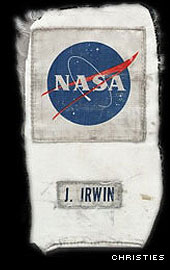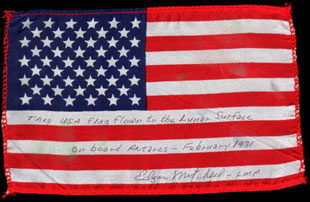Collecting Lunar Artifacts
by Joe Davies
The Moon and the Earth are forever bound together in a dance of the ages. Throughout history, humankind has developed a special relationship with our celestial neighbour - civilizations have worshiped the Moon, it controls our tides, and whom among us has not marvelled at it during our formative years?
And to think we went there - it was an astonishing accomplishment, one just as likely not be repeated in our lifetimes, and maybe never again. As we continue our exploration of the solar system, the Moon may very well be bypassed in the goal of greater challenges.
During our missions to the Moon, very few artifacts that reached the lunar surface returned to Earth. There were the rocks that were harvested and are now locked away in NASA vaults. There were the spacesuits worn by the astronauts during their moonwalks, now similarly locked away in the Smithsonian. So, what else was there?
The short answer is "very little," consisting mainly of mementos and souvenirs that the astronauts brought back with them as their personal souvenirs. Genuine lunar surface artifacts are some of the rarest items on the planet, and excluding the spacesuits and rocks, the total hoard might easily fit into a small suitcase.
The Pecking Order
There is an order among collectors to the precedence of lunar artifacts.
At the bottom of the list are those items that were flown to the Moon but that remained in orbit. These are relatively plentiful and at least one major dealer usually has stock items from a selection of lunar missions available. The weight restrictions aboard the Command Module (CM) were not as inhibiting as the Lunar Module (LM) and several astronauts took the opportunity to fly relatively large numbers of items in their PPKs (Personal Preference Kits).
Next are those items flown to the lunar surface itself. Mainly, these are mementoes kept within the PPKs aboard the LM, and smaller mission hardware artifacts (such as cue cards) used within the lander. These artifacts are rarer than those flown to orbit and attract significantly higher interest as they made the full journey to the surface.
Then there are those artifacts taken out onto the lunar surface but not exposed to space. In practice, this means they were probably carried inside a spacesuit pocket. There are very few of these, but as an example David Scott did carry some small flags and miniature copies of the first lunar rover license plate in a spacesuit pocket throughout Apollo 15.
Lastly, we come to the pinnacle, those items used on the lunar surface during the mission. These are exceedingly rare as except for the spacesuits and film rolls, nearly all the hardware used on the surface remained there. These artifacts are invariably covered in moon dust.
Moon Dust and Rocks
The allure of lunar material is seductive. As such, there is always a temptation for any lunar artifact to be presented as that it had been stained with moon dust.
The reality is that if it wasn't used on the surface then it probably was not soiled. Of course, only a scientific examination can determine one way or the other, but this isn't the easiest thing to obtain, so artifacts pop up with "moon dust" in their description.
Apollo 17 moonwalker Harrison Schmitt tells that moon dust has many of the properties of graphite powder but exhibits contradictory qualities - a seemingly impossible combination of lubrication and abrasion. It is extremely fine grained and "sticky" - it adheres to every- and any-thing and is completely unlike the household dust we are familiar. Remember, it hasn't been subject to the erosive and weathering elements. If you touch moon dust and then rub your finger and thumb together even the tiniest trace will cause a slight feeling of slipperiness.
The ultimate, of course, is the moon rocks.
If you are ever offered a moon rock you must consider two things: it is in all likelihood not authentic and if indeed real, there are certain rules and laws governing the ownership of moon material, which basically translates to the authorities having the right to confiscate the rock and drag you off to a room with iron bars over the windows. These same rules theoretically apply to moon dust, but experience and observation lend to a conclusion that the restrictions are more relaxed when rocks are not involved.
Spacesuits
The 12 spacesuits worn during the Extravehicular Activities (EVAs) by the Apollo moonwalkers were a variant of the "standard" CM spacesuit with extra insulation and radiation protection. All of these suits are now the property of the Smithsonian - usually three or so are on display either at the National Air and Space Museum in Washington, DC or on loan elsewhere, and the rest are kept in a temperature and humidity controlled vault in the Smithsonian's Garber Facility.
All the spacesuits are intact so if you are ever offered a piece of spacesuit from the Moon, then it isn't what it purports to be. The exception are some of the Portable Life Support System (PLSS) straps, which clipped the lunar backpacks to the spacesuit and were to be left on the moon, but at least a few of the astronauts brought theirs home for their personal collections.
 One other notable exception is the patches from the PLSS backpack which again, a few astronauts cut from the PLSS before jettisoning them out of the LM. One other notable exception is the patches from the PLSS backpack which again, a few astronauts cut from the PLSS before jettisoning them out of the LM.
Mementos
The artifacts that you will find most available and those that in all likelihood will provide the stock from that you may purchase are the "mementos". These are comprised of two groups, the PPK contained items and the mission hardware.
PPK items are usually any of the following: small flags, mission patches, postal covers, medallions, and trinkets (e.g. the Apollo 15 replica LRV license plates). Each astronaut had several PPKs and every PPk was listed on the flight manifest but the contents were the personal choice of each astronaut and were not made publicly available.
Available mission hardware is varied -- from larger artifacts such as a map and camera down to small cue cards and spacesuit accessories. Over the last few years a good number of such artifacts have been acquired from the astronauts personal collections and have found their way to the secondary marketplace.
Authentication
The value of a lunar artifact is directly proportional to the quality of the documented evidence supporting its history and authenticity. Arguably, the absolute arbiters of what is genuine are the astronauts themselves. After all, they were there and we were not. If a moonwalker astronaut says something was on the surface of the Moon with him, then it was there, end of story.

An American flag, stained with moon dust, inscribed by Apollo 14 astronaut Edgar Mitchell: "This USA flown flag to the Lunar Surface on board Antares -- February 1971". Copyright © 2000 Joe Davies
Buying direct from an astronaut is generally preferable, as this also gives another important aspect of authenticity, the chain of custody. If you do buy from an intermediary, ensure you obtain a letter of transfer of ownership that keeps this chain intact. Once broken the links of this chain can rarely, if ever be repaired.
The optimum documentation may be to have the astronaut inscribe onto the surface of the artifact the details of where and when it was flown, to provide a separate letter of authenticity and to have a photograph of the astronaut inscribing the artifact in person.
Remember that hearsay, interesting anecdotes, personal assurances and "guarantees" do not provide authenticity. They may enhance and give you a warm feeling but ultimately hard, solid, irrefutable evidence, provenance, history and custodianship are the only ways to ensure the authenticity of what you buy.
The exception is for the smaller items of hardware such as kapton gold foil, parachute line fragments, slivers of exposed film and other such pieces of history. In their case the best arbiter of authenticity is the NASA engineer who personally removed the item from the spacecraft.
Value
Given the rarity of these artifacts any attempt at preparing a price guide is a fruitless task. At one end of the scale, genuine small swatches of beta cloth have sold for the low hundreds and at the other end, important artifacts used on the actual surface have sold for tens and as much as hundreds of thousands of dollars.
Ownership of Artifacts
Before you ever get a chance to acquire a lunar artifact it has to have been relinquished by its original owner. That's an obvious statement but with lunar artifacts it is not such a simple matter. NASA provides first right of refusal for all artifacts it no longer has use of to the Smithsonian. This applies to all hardware that was originally intended for return to Earth from the Moon.
Items not manifested for the trip home, such as anything the astronauts decided to salvage, are not the property of the Smithsonian and in most cases, remain with the astronauts. Items flown in the astronauts' PPKs are also their property.
Artifacts overlooked or refused by the Smithsonian, may have been offered by NASA to other museums, returned to the contractors that provided them, or were discarded through government sales and auctions.
Where to Buy
There are four main sources of lunar artifacts for sale: the astronauts, auction houses, dealers, and collectors.
As already mentioned, the preferred situation is to deal directly with the astronauts. Albeit, this does limit the opportunities and it may not be easy to make contact with one, but some are approachable to serious inquiries (though 30 years of wishful thinkers and dreamers has somewhat caused them to remain skeptical of most inquiries). If buying direct, you have the opportunity to insure the documented history and provenance is exactly as it should be and this alone is worth the effort. There is also something almost magical about acquiring an item direct from the person who flew it. The reality though, is this isn't always possible so one must seek opportunities within the space memorabilia marketplace.
Despite their public appeal, auction houses may not the best place to buy artifacts. Invariably, auction lots have their chain of ownership broken, the provenance provided is usually weaker or sometimes even suspect, and you are immediately paying a hefty premium in commission.
Reputable dealers can be a good source, but finding a good dealer is often easier said than done.
Enthusiastic and knowledgeable collectors may make one of the best sources, but your challenge is convincing them to sell!
Instead, seek advice from experienced collectors as to their recommendations for sources, ensure anything you consider purchasing has solid provenance and use the cardinal test of whether there are any doubts in your own mind as to the item's authenticity.
|

 One other notable exception is the patches from the PLSS backpack which again, a few astronauts cut from the PLSS before jettisoning them out of the LM.
One other notable exception is the patches from the PLSS backpack which again, a few astronauts cut from the PLSS before jettisoning them out of the LM.